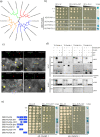The mutualism effector MiSSP7 of Laccaria bicolor alters the interactions between the poplar JAZ6 protein and its associated proteins
- PMID: 33230111
- PMCID: PMC7683724
- DOI: 10.1038/s41598-020-76832-6
The mutualism effector MiSSP7 of Laccaria bicolor alters the interactions between the poplar JAZ6 protein and its associated proteins
Abstract
Despite the pivotal role of jasmonic acid in the outcome of plant-microorganism interactions, JA-signaling components in roots of perennial trees like western balsam poplar (Populus trichocarpa) are poorly characterized. Here we decipher the poplar-root JA-perception complex centered on PtJAZ6, a co-repressor of JA-signaling targeted by the effector protein MiSSP7 from the ectomycorrhizal basidiomycete Laccaria bicolor during symbiotic development. Through protein-protein interaction studies in yeast we determined the poplar root proteins interacting with PtJAZ6. Moreover, we assessed via yeast triple-hybrid how the mutualistic effector MiSSP7 reshapes the association between PtJAZ6 and its partner proteins. In the absence of the symbiotic effector, PtJAZ6 interacts with the transcription factors PtMYC2s and PtJAM1.1. In addition, PtJAZ6 interacts with it-self and with other Populus JAZ proteins. Finally, MiSSP7 strengthens the binding of PtJAZ6 to PtMYC2.1 and antagonizes PtJAZ6 homo-/heterodimerization. We conclude that a symbiotic effector secreted by a mutualistic fungus may promote the symbiotic interaction through altered dynamics of a JA-signaling-associated protein-protein interaction network, maintaining the repression of PtMYC2.1-regulated genes.
Conflict of interest statement
The authors declare no competing interests.
Figures






Similar articles
-
Effector MiSSP7 of the mutualistic fungus Laccaria bicolor stabilizes the Populus JAZ6 protein and represses jasmonic acid (JA) responsive genes.Proc Natl Acad Sci U S A. 2014 Jun 3;111(22):8299-304. doi: 10.1073/pnas.1322671111. Epub 2014 May 20. Proc Natl Acad Sci U S A. 2014. PMID: 24847068 Free PMC article.
-
Populus MYC2 orchestrates root transcriptional reprogramming of defence pathway to impair Laccaria bicolor ectomycorrhizal development.New Phytol. 2024 Apr;242(2):658-674. doi: 10.1111/nph.19609. Epub 2024 Feb 20. New Phytol. 2024. PMID: 38375883
-
The small secreted effector protein MiSSP7.6 of Laccaria bicolor is required for the establishment of ectomycorrhizal symbiosis.Environ Microbiol. 2020 Apr;22(4):1435-1446. doi: 10.1111/1462-2920.14959. Epub 2020 Mar 2. Environ Microbiol. 2020. PMID: 32090429
-
The Laccaria genome: a symbiont blueprint decoded.New Phytol. 2008;180(2):296-310. doi: 10.1111/j.1469-8137.2008.02613.x. New Phytol. 2008. PMID: 19138220 Review.
-
Jasmonic Acid Signaling and Molecular Crosstalk with Other Phytohormones.Int J Mol Sci. 2021 Mar 13;22(6):2914. doi: 10.3390/ijms22062914. Int J Mol Sci. 2021. PMID: 33805647 Free PMC article. Review.
Cited by
-
Comparative transcriptomics uncovers poplar and fungal genetic determinants of ectomycorrhizal compatibility.Plant J. 2025 Jul;123(2):e70352. doi: 10.1111/tpj.70352. Plant J. 2025. PMID: 40700644 Free PMC article.
-
The Multifaceted Roles of MYC2 in Plants: Toward Transcriptional Reprogramming and Stress Tolerance by Jasmonate Signaling.Front Plant Sci. 2022 Apr 25;13:868874. doi: 10.3389/fpls.2022.868874. eCollection 2022. Front Plant Sci. 2022. PMID: 35548315 Free PMC article. Review.
-
To immunity and beyond: the central role of jasmonate signalling in beneficial root-microbe-environment interactions.New Phytol. 2025 Sep;247(6):2564-2570. doi: 10.1111/nph.70446. Epub 2025 Aug 7. New Phytol. 2025. PMID: 40772406 Free PMC article. Review.
-
Metatranscriptomics captures dynamic shifts in mycorrhizal coordination in boreal forests.Proc Natl Acad Sci U S A. 2022 Jun 28;119(26):e2118852119. doi: 10.1073/pnas.2118852119. Epub 2022 Jun 21. Proc Natl Acad Sci U S A. 2022. PMID: 35727987 Free PMC article.
-
Plant-Fungi Mutualism, Alternative Splicing, and Defense Responses: Balancing Symbiosis and Immunity.Int J Mol Sci. 2025 May 28;26(11):5197. doi: 10.3390/ijms26115197. Int J Mol Sci. 2025. PMID: 40508007 Free PMC article. Review.
References
-
- Bücking H, Hans R, Heyser W. The apoplast of ectomycorrhizal roots—site of nutrient uptake and nutrient exchange between the symbiotic partners. In: Sattelmacher B, Horst WJ, editors. The Apoplast of Higher Plants: Compartment of Storage, Transport and Reactions. Dordrecht: Springer; 2007. pp. 97–108.
-
- Gange AC, Gane DRJ, Chen YL, Gong MQ. Dual colonization of Eucalyptus urophylla ST Blake by arbuscular and ectomycorrhizal fungi affects levels of insect herbivore attack. Agric. For. Entomol. 2005;7:253–263. doi: 10.1111/j.1461-9555.2005.00268.x. - DOI
-
- Beniwal RS, Langenfeld-Heyser R, Polle A. Ectomycorrhiza and hydrogel protect hybrid poplar from water deficit and unravel plastic responses of xylem anatomy. Environ. Exp. Bot. 2010;69:189–197. doi: 10.1016/j.envexpbot.2010.02.005. - DOI
Publication types
MeSH terms
Substances
Supplementary concepts
LinkOut - more resources
Full Text Sources

